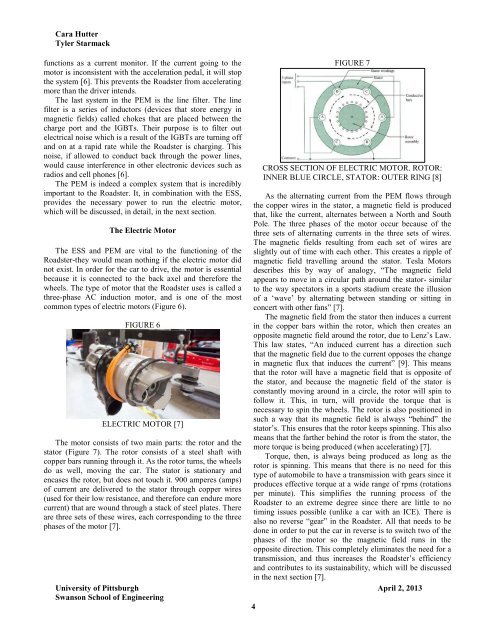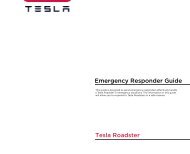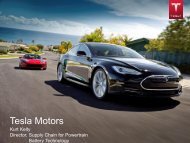TESLA ROADSTER: THE NEW STANDARD OF ELECTRIC AUTOMOBILES
Create successful ePaper yourself
Turn your PDF publications into a flip-book with our unique Google optimized e-Paper software.
Cara Hutter<br />
Tyler Starmack<br />
functions as a current monitor. If the current going to the<br />
motor is inconsistent with the acceleration pedal, it will stop<br />
the system [6]. This prevents the Roadster from accelerating<br />
more than the driver intends.<br />
The last system in the PEM is the line filter. The line<br />
filter is a series of inductors (devices that store energy in<br />
magnetic fields) called chokes that are placed between the<br />
charge port and the IGBTs. Their purpose is to filter out<br />
electrical noise which is a result of the IGBTs are turning off<br />
and on at a rapid rate while the Roadster is charging. This<br />
noise, if allowed to conduct back through the power lines,<br />
would cause interference in other electronic devices such as<br />
radios and cell phones [6].<br />
The PEM is indeed a complex system that is incredibly<br />
important to the Roadster. It, in combination with the ESS,<br />
provides the necessary power to run the electric motor,<br />
which will be discussed, in detail, in the next section.<br />
The Electric Motor<br />
The ESS and PEM are vital to the functioning of the<br />
Roadster-they would mean nothing if the electric motor did<br />
not exist. In order for the car to drive, the motor is essential<br />
because it is connected to the back axel and therefore the<br />
wheels. The type of motor that the Roadster uses is called a<br />
three-phase AC induction motor, and is one of the most<br />
common types of electric motors (Figure 6).<br />
FIGURE 6<br />
<strong>ELECTRIC</strong> MOTOR [7]<br />
The motor consists of two main parts: the rotor and the<br />
stator (Figure 7). The rotor consists of a steel shaft with<br />
copper bars running through it. As the rotor turns, the wheels<br />
do as well, moving the car. The stator is stationary and<br />
encases the rotor, but does not touch it. 900 amperes (amps)<br />
of current are delivered to the stator through copper wires<br />
(used for their low resistance, and therefore can endure more<br />
current) that are wound through a stack of steel plates. There<br />
are three sets of these wires, each corresponding to the three<br />
phases of the motor [7].<br />
FIGURE 7<br />
CROSS SECTION <strong>OF</strong> <strong>ELECTRIC</strong> MOTOR. ROTOR:<br />
INNER BLUE CIRCLE, STATOR: OUTER RING [8]<br />
As the alternating current from the PEM flows through<br />
the copper wires in the stator, a magnetic field is produced<br />
that, like the current, alternates between a North and South<br />
Pole. The three phases of the motor occur because of the<br />
three sets of alternating currents in the three sets of wires.<br />
The magnetic fields resulting from each set of wires are<br />
slightly out of time with each other. This creates a ripple of<br />
magnetic field travelling around the stator. Tesla Motors<br />
describes this by way of analogy, “The magnetic field<br />
appears to move in a circular path around the stator- similar<br />
to the way spectators in a sports stadium create the illusion<br />
of a ‘wave’ by alternating between standing or sitting in<br />
concert with other fans” [7].<br />
The magnetic field from the stator then induces a current<br />
in the copper bars within the rotor, which then creates an<br />
opposite magnetic field around the rotor, due to Lenz’s Law.<br />
This law states, “An induced current has a direction such<br />
that the magnetic field due to the current opposes the change<br />
in magnetic flux that induces the current” [9]. This means<br />
that the rotor will have a magnetic field that is opposite of<br />
the stator, and because the magnetic field of the stator is<br />
constantly moving around in a circle, the rotor will spin to<br />
follow it. This, in turn, will provide the torque that is<br />
necessary to spin the wheels. The rotor is also positioned in<br />
such a way that its magnetic field is always “behind” the<br />
stator’s. This ensures that the rotor keeps spinning. This also<br />
means that the farther behind the rotor is from the stator, the<br />
more torque is being produced (when accelerating) [7].<br />
Torque, then, is always being produced as long as the<br />
rotor is spinning. This means that there is no need for this<br />
type of automobile to have a transmission with gears since it<br />
produces effective torque at a wide range of rpms (rotations<br />
per minute). This simplifies the running process of the<br />
Roadster to an extreme degree since there are little to no<br />
timing issues possible (unlike a car with an ICE). There is<br />
also no reverse “gear” in the Roadster. All that needs to be<br />
done in order to put the car in reverse is to switch two of the<br />
phases of the motor so the magnetic field runs in the<br />
opposite direction. This completely eliminates the need for a<br />
transmission, and thus increases the Roadster’s efficiency<br />
and contributes to its sustainability, which will be discussed<br />
in the next section [7].<br />
University of Pittsburgh April 2, 2013<br />
Swanson School of Engineering<br />
4







